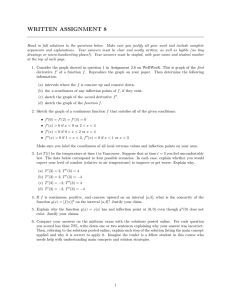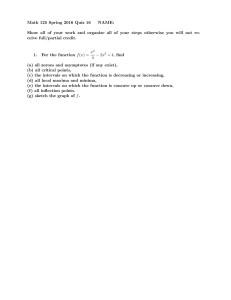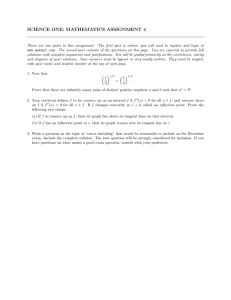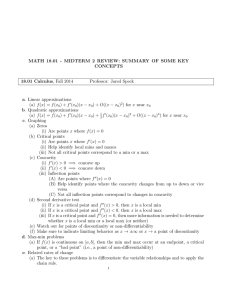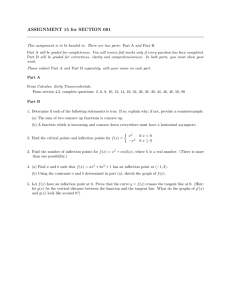Problem Set 3.2 160
advertisement
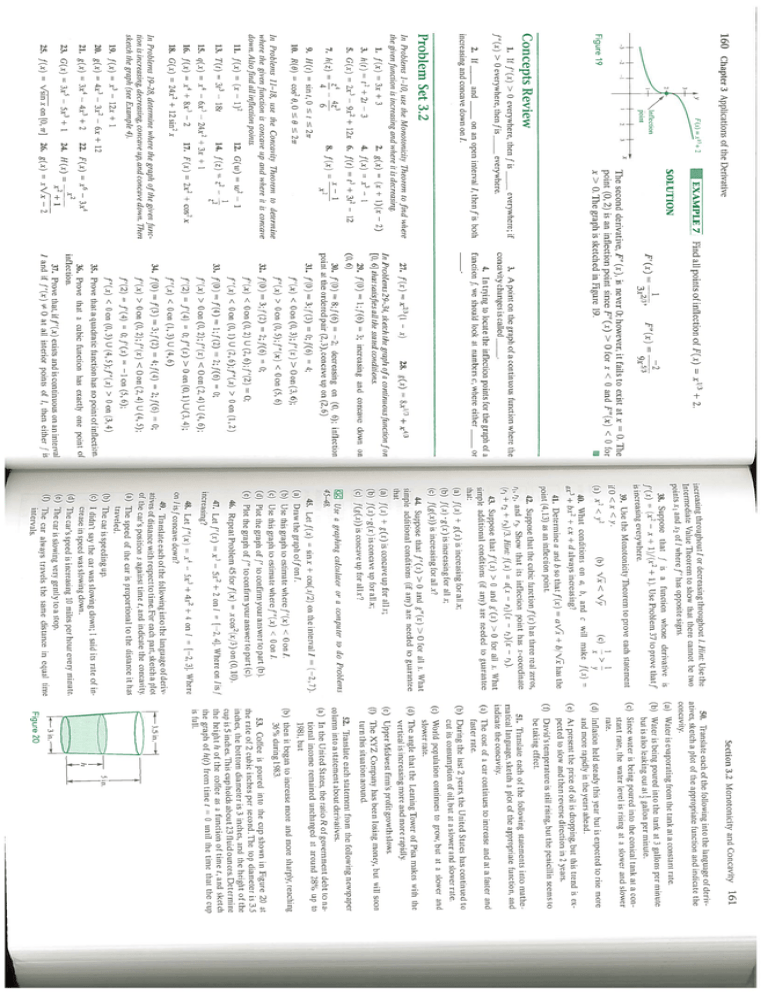
160 —3 —1 y 3 F(x)=x’°+2 \lnnecrion poini ! -x 2t 3x + 3 2 + t — 3 0 2 2. g(x) 4. f(x) 8. f(x) 2 + 12x 6. f(t) 9x 6,O 2 cos = (x = 4 3x 3 4x — — — 32 = 1 — (x + 1)(x — 2 3 -I- 3t t 3 s = sl = = 22. F(x) 6x + 12 3 + 2 4x 24. H(s) — 3 + 1 5x = = = — 1 — 12 x 2 2 -I- cos 2x — 3.4 2 + 1 x 2) = ’ 2 3x F”(.v) = = 9x’ Find all points of inflection of F( x) F(s) f() f”(x) [(0) = = 23(1 1;f(6) — = = x) 3 -I- 2. .r’ 28. g(x) = 8x1’3 + 3; increasing and concave down on 0;f(6) Don (0, 3); f’ (x) 3;f(3) < 3;f(2) = 2;f(6) = 0 on (3, 6); 4; > = 0; = 0; > Don (0, 5);f”(x) < Don (5, 6) = = = 0; f’(s) f’(r) 3;f(2) = 2;f(6) 4;f(4) = 0; 2;f(6) > = 0; Don (3,4) —ion (5, 6); <0 on (2,4) U (4, 5); = 2); f’ (t) <0 on (2,4) U (4, 6); f’ (x) > 0 on (0,1) U (3, 4); 0; 1;f(2) Don (0,1) U (2,6);f’(x) > Don (1,2) f’(.x) < Oon (0, 2) U (2, 6);f’(2) < f’(4) Don (0, [(4) > = f’(x) = = Don (1, 3) U (4,6) f(3) < = f’(4) f”(x) < Don (0,3) U (4,5);f”(x) [‘(2) f’(x) > Don (0, 2); 34. [(0) f”(x) f’(2) 33. [(0) 32. 31. f(0) 8;f(6) = —2; decreasing on (0, 6); inflection 30. f(0) point at the ordered pair (2.3), concave up on (2.6) 29. f(0) (0, 6) [0, 6] that satisfies all the stated conditions. In Problems 29—34, sketch the graph of a continuous fnnction f on 27. The second derivative, F” (x), is never 0; however, it fails to exist at x = 0. The point (0,2) is an inflection point since F”(x) > 0 for x < 0 and F”(x) < 0 for x > 0. The graph is sketched in Figure 19. SOLUTION • EXAMPLE 7 Chapter 3 Applications of the Derivative —2 Figure 19 Concepts Problem Set 3.2 = = 3 2x =— = — In Problems 1—10, use the Mon otonicity Theorem to find where the given function is increasing and where it is decreasing. 1. f(x) 3. h(t) 5. G(x) 7. h(z) = 9. H(t)=sint,0t2ir 10. R(0) 12. G(w) 11. f(x) 17. F(s) — In Problems 11—18, use the Concavity Theorem to determine where the given function is concave up and where it is concave down. Also find all inflection points. 1)2 14. f(z) 3 3t — 18t = — — 13. T(t) 4 x 2 2 -I- 3x + 1 24x = 3 4 + 8x x — 15. q(x) = 2x 2 + 12 sin 24x 3 6x 16. f(x) = — 18. G(x) 20. g(x) = 5 3x = In Problems 19—28, determine where the graph of the given fluic tion is increasing, decreasing, concave up, and concave down. Then sketch the graph (see Example 4). 21. g(x) = 19. f(x)=x —12x-l-1 3 23. G(x) 35. Prove that a quadratic function has no point of inflection. 36. Prove that a cubic function has exactly one point of inflection. 37. Prove that, if f’(x) exists and is continuous on an interval I and if f’(x) 0 at all interior points of I, then either f is — jncreasing throughout I or decreasing throughout I. 1-lint: Use the Intermediate Value Theorem to show that there cannot be two 2 of I where has opposite signs. 1 and x f’ points x is 38. Suppose that f is a function whose derivative 2 ± 1). Use Problem 37 to prove thatf x H- 1)/(.v 2 (x f(s) is jncreasiflg everywhere. 39. Use the Wlonotonicity Theorem to prove each statement iffl < x < y. (c) < (b) 2 (a) x2 < y , . — — — 49. What conditions on a, b, and c will make f(s) = 2 + cx + d always increasing? 3 + bx as b/sLi: has the 41. Determine a and b so that f(x) = a/ Hpoint (4,13) as an inflection point. 42. Suppose that the cubic function f(s) has three real zeros, . Show that its inflection point has s-coordinate 3 , and r 2 r ). 3 )(x r 2 r ) (x 1 )/3. 1-lint: f(s) = a(x r 3 2 -I- r 1 -I- r (r 43. Suppose that f(s) > 0 and g’(x) > 0 for all x. What simple additional conditions (if any) are needed to guarantee that: (a) f(s) + g(x) is increasing for alIx; (b) f(s) g(x) is increasing for all x; (c) f(g(x)) is increasing for all x? 44. Suppose that f(s) > 0 and g”(r) > 0 for all x. What simple additional conditions (if an’) are needed to guarantee that (a) f(s) -I- g(.r) is concave up for aIls; (b) f(s) .g(x)is concave up for alIx: (c) f(g(s)) is concave up for ails? Use a graphing calculator or a computer to do Problems 45-48. f’(x) = — 52 -F- = 2 onl 46. Repeat Problem 45forf(x) = [—2, 41. Where on lisf (x/3) on (0,10). 2 xcos (—2,7). 45. Letf(x) = sinx -t- cos(s/2) on the intervall (a) Draw the graph offon I. (b) Use this graph to estimate where f’(x) < OonI. (c) Use this graph to estimate where f”(x) < Don 1. (d) Plot the graph off’ to confirm your answer to part (b). (e) Plot the graph of f” to confirm your answer to part (c). 47. Let increasing? — 48. Let f”(x) = 5x H- 42 4 on I = [—2, 31. Where on Iisf concave down? 49. Translate each of the following into the language of deriv atives of distance with respect to time.For each part, sketch a plot of the car’s position s against time t, and indicate the concavity. (a) The speed of the car is proportional to the distance it has traveled. (b) The car is speeding up. (c) I didn’t say the car was slowing down; I said its rate of in crease in speed was slowing down. (d) The car’s speed is increasing 10 miles per hour every minute. (e) The car is slowing very gently to a stop. (f) The car always travels the same distance in equal time intervals. Section 3.2 Monotonicity and Concavity 161 50. Translate each of the following into the language of deriv atives, sketch a plot of the appropriate function and indicate the concavity. (a) Water is evaporating from the tank at a constant rate. (b) Water is being poured into the tank at 3 gallons per minute but is also leaking out at gallon per minute. (c) Since water is being poured into the conical tank at a con stant rate, the water level is rising at a slower and slower rate. (d) Inflation held steady this ‘ear but is expected to rise more and more rapidly in the years ahead. (e) At present the price of oil is dropping. but this trend is ex pected to slow and then reverse direction in 2 years. (f) David’s temperature is still rising, but the penicillin seems to be taking effect. 51. Translate each of the following statements into mathe matical language, sketch a plot of the appropriate function, and indicate the concavity. (a) The cost of a car continues to increase and at a faster and faster rate. (b) During the last 2 years, the United States has continued to cut its consumption of oil, but at a slower and slower rate. (c) World population continues to grow, but at a slower and slower rate. (d) The angle that the Leaning Tower of Pisa makes with the vertical is increasing more and more rapidly. (e) Upper Midwest firms profit growth slows. (f) The XYZ Company has been losing money, but will soon turn this situation around. 36% during 1983. 52. Translate each statement from the following newspaper column into a statement about derivatives. (a) In the United States, the ratio R of government debt to na tional income remained unchanged at around 28? up to 1981, but (b) then it began to increase more and more sharply, reaching 53. Coffee is poured into the cup shown in Figure 20 at the rate of 2 cubic inches per secord.The top diameter is 3.5 inches, the bottom diameter is 3 inches, and the height of the cup is 5 inches. This cup holds about 23 fluid ounces, Determine the height Ii of the coffee as a function of time t, and sketch the graph of hQ) from time t = 0 until the time that the cup is full.
